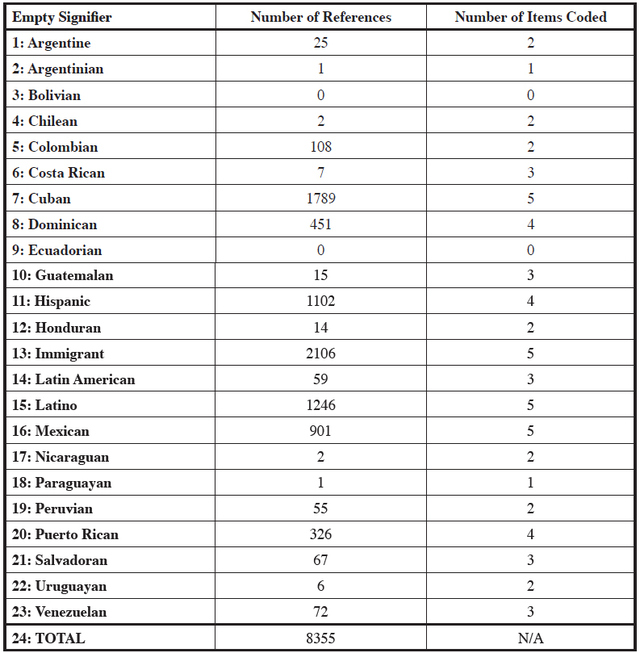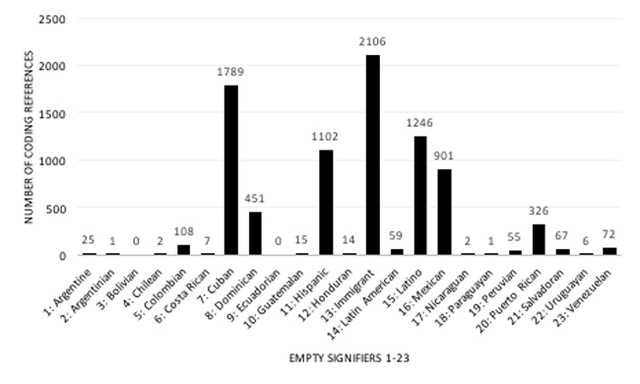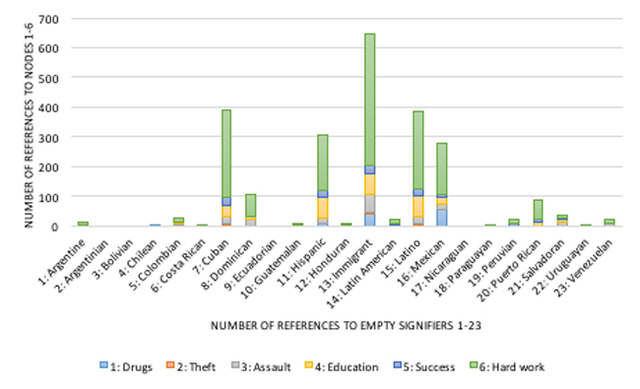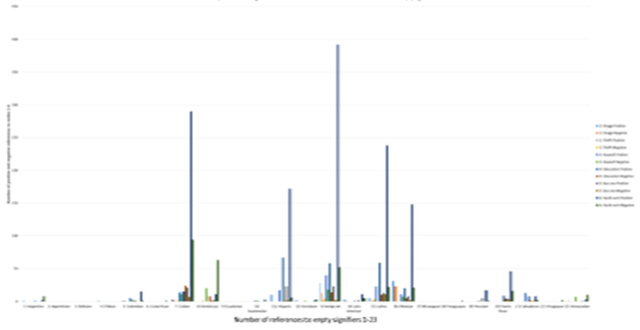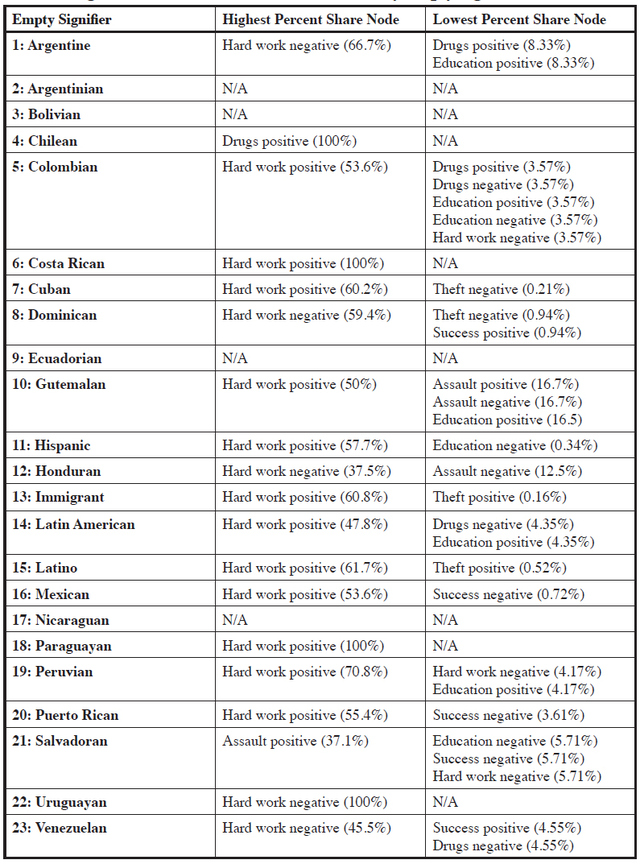From Clocks and Clouds VOL. 7 NO. 1Belonging in a New Home: Discursive Othering of Latin American Immigrants in U.S. Print Media
IN THIS ARTICLE
AbstractThe year 2015 saw heightened racial and ethnic tension in the United States, with particular regard to Latin American immigrants and the U.S. presidential election. Discourse theory assumes that identity (re)production serves to legitimize, institutionalize, and eventually internalize hegemonic and resistant discursive portrayals of political actors and actor groups. Some discourse analysts attempts to "reveal racism" in society and combat that racism. Yet, to the extent that "racism" represents a series of systemic and systematically oppressive power structures, highlighting racist prejudices in media, policy, popular, or other discourses only scratches the surface of discriminatory identity construction. This study (1) employs Critical Discourse Analysis (CDA) to analyze the seven most widely circulated U.S. print newspapers' (re)presentations of Latin American immigrants in 2015, (2) challenges the popular notion of discourse's non-quantifiability in CDA research, and (3) ruminates on the implications of media (re)presentations of actors for their political agency. IntroductionAnyone paying attention to the 2016 U.S. presidential election undoubtedly noticed intensified rhetoric charged at the country's Latin American population, indicating, for some, a potential regression into visceral and inflamed racial and ethnic relations (Milligan 2016). In fact, some reports indicate that members of the U.S. Latino population have been targeted specifically for their ethnicity, with their attackers citing Donald Trump's views on immigration as motivation (Berman 2015). According to the Boston Globe, one of the attackers told police, "Donald Trump was right, all these illegals need to be deported" (Ibid). Moreover, such violence does not represent an isolated incident; America's Voice—an immigration reform advocacy group— has mapped "documented instances where Donald Trump, his supporters, or his staff harassed or attacked Latinos and immigrants" across the country (America's Voice 2016). Representations of Latin Americans as illegal immigrants, job-stealers, and so on thus permeate into popular discourse, likely leading to disastrous effects on their human rights. But how are Latin Americans portrayed in other societal contexts? Considering that socially constructed identities consist of multiple, layered discourses, we should remain skeptical that the above popular representation necessarily characterizes the dominant U.S. discourse on Latin American identity. Indeed, it is unclear if the popular discourse simply receives disproportionate representation relative to other discourses' share of the total U.S. political debate. For example, how do dominant U.S. media discourses represent Latin Americans? Scholars have shown awareness of media's role in (re) producing the language, symbols, meanings, concepts, knowledge, and so on of a particular discourse in addition to (re)producing the language, symbols, meanings, concepts, knowledge, and so on developed within media discourses themselves (O'Keefe 2011). I seek to investigate discursive representations of Latin Americans within the seven most widely circulated U.S. newspapers in 2015 through the lens of critical discourse analysis (CDA). I further adopt CDA with the assumption that it can employ a mixed-methods analysis, bridging the traditional dichotomy between quantitative and qualitative research (Wetherell, Taylor, and Yates 2011, 10). Ultimately, I argue that dominant U.S. media discourses present a two-tiered image of Latin Americans. On one level, Latin Americans are portrayed overwhelmingly positively, particularly in regard to hard work. On a second level, however, these surface-level positives obscure deeper, tokenizing, paternalistic, and victimizing themes that other Latin Americans and endanger their political agency. Discursive and Institutional Perspectives on Othering: A Review of Contemporary Scholarship on Ethnicity, Immigration, and DiscriminationTwo significant schools of thought attempt to address the question of Latin American immigration and integration: one discursive and one institutional. Although innumerable approaches to migration questions exist, from economics to national security and beyond, both schools of thought do so in terms of human rights. This paper similarly adopts a human rights-based approach, interpreting the primary purpose of migration and migration law as the protection of the rights of migrants, not vague notions of national security or economics. The theoretical inviolability of human rights thus renders such former concerns largely inapposite for all present intents and purposes. The discursive school of thought attempts to advance theoretical claims about how different societal actors use language to give meaning to different ethnicities in society, thus attempting to "reveal racism" in myriad different discursive regimes (Herzog et al. 2009). Scholars in this school of thought propose that nativist discourses marginalize Latin American immigrants by constructing their identities as an intrinsically different "other" to the national "self" (Otazu 2002, Marshall 2007, van Dijk 2005). For example, Herzog et al. (2009) claim that Spanish nativist discourses use drug and alcohol consumption as a scapegoat for ethnic discrimination, casting all or most Latin American immigrants in the same light. According to Herzog et al. (2009), this discursive othering results in less successful integration on the part of the othered community—in this case, Latin American immigrants. Not all of these assumed differences are inherently negative, however. According to Fernández-Lasquetty (2010, 58), problems confronting immigrants do not comprise "reception, idiomatic difficulties, or adapting to the [the host country's] way of life" so much as they comprise the same concerns as natives, such as unemployment and local politics. Discourse analysts challenge these assumptions and ultimately claim that nativist discourses that assume immigrants to possess inherent or irreconcilable differences from native populations lead to racism and marginalization. Most discourse analysts assume that the rhetorical and discursive othering they interrogate translates into material oppression for othered communities. It is, however, unclear whether or not oppressive discourses translate into "realworld" discrimination. Certainly discourse analysis can reveal prejudices, but to claim that it reveals racism in terms of a systemic, collective, and ongoing cycle of oppression may exceed what available evidence concedes. Furthermore, that discourse analysts have largely focused exclusively on nativist discourses contradicts their own central tenet—leaving an oppressed community's voice out of a conversation about that community's experience is itself a form of metaoppression. This study does not index Latin Americans self-construction of identity, but it interrogates the social construction of Latin American identity by popular print media sources and assumes that media discourses factor into identity construction as only one layer of a multi-layered discursive regime. Institutionalists, by contrast, explicate Latin American marginalization in terms of the tensions and contradictions within official government policy (Ivan 2009). On the one hand, for example, Latin American immigration in Spain is unsurprising because of close "linguistic and cultural-colonial ties" (Calavita, Garzón, and Cachón 2006, 191). Yet, on the other hand, institutionalists claim that Spanish law itself "produced [irregular migration]" by criminalizing some forms of immigration but not others, thus resulting in fear and lack of integration due to the threat of deportation and other penal factors for migrants (Ibid). Some institutionalist scholars propose a "feed-back" model of immigration, whereby local populations' interactions with immigrant populations and their perceptions of immigrants from mass media and political discourse influence their interactions with immigrants in a certain way (Solé et al. 2000, 133-134). If an "attitude of rejection" presides among the local population, then it can "promote labor and economic exclusion" and "legitimize the institutional mechanisms of discrimination themselves" (Ibid, 135). In other words, immigrants' lack of integration into the host country's society reinforces negative stereotypes of immigrant populations, thereby furthering the notion of immigrants' intrinsic differences compared to native populations. The principal criticism of institutionalism is that it overemphasizes the relevance of top-down structures (Herrigel 2005). In fact, precisely because institutions consist of people and depend on them to construct their rules, values, and norms, the discrimination that results from any institution ultimately results from the social construction of institutions in the first place. Institutions dealing with migration are no different; that the Spanish law "produced [irregular migration]" where none such existed previously means that the type of migration subsequently classified as irregular could not have been so were it not for the particular values determinant of that distinction (Calavita, Garzón, and Cachón 2006, 191). In this paper, I adopt both the general disposition of the discursive school and that of its critics. Studies like Herzog et al.'s that employ Critical Discourse Analysis (CDA) adopt, on one level, a post-structural conception of discourse as any social practice that communicates meaning from one actor to another. However, the claim that simply identifying prejudices in nativist discourses reveals racism implicitly assumes a Foucauldian-Derridean logic of discourse, in supposing that language is "constitutive of consciousness from the outset," and that discursive prejudices are "real-world" forms of discrimination (Derrida 1973, 6-7; Howells 1998, 43-44; Foucault 2002). The value-added of this logic of discourse lies in its analysis of discursive structures. I do not deny the bitter cruelty of discursive prejudices; however, I assume that the discursive representation of the world does not necessarily fully reflect life or the state of the world's affairs. Whereas a Foucauldian-Derridean logic assumes that humans are subjectified by myriad discursive structures, I assume that all discursive actors have agency, and are "(re)produc[e] shared meanings, related interests, [potentially] aiming to impose them on others" (Leipold and Winkel 2013, 7). Hence, making claims about a way of life that rely exclusively on others' claims about that way of life for evidentiary support reflects a certain tautological reasoning, lending itself more than anything to confirmation bias and conceptual obscurity. I concede that discourse consists of any social practice that communicates meaning from one actor to another, but I deny that language constitutes actors' relations from the outset, or as Alexander Wendt puts it, that the world is made up of "discourses all the way down" (Wendt 1999, 110). By maintaining the distinction between language and an independent, physical reality, this paper's logic of discourse raises the threshold level of evidentiary support for oppression claims. In order to demonstrate that discrimination exists as a structural or systemic societal problem, it is not sufficient to show that prejudices exist. Rather, one must explain how those prejudices translate into negative consequences for oppressed persons and communities, however the latter may be defined. Here, I focus only on media discourses in a similar style as Herzog et al., but I refrain from claiming that this paper reveals any racism or oppression in practice—only in discourse. This study therefore adopts the discursive school of thought's methodological premises, but seeks to improve its conceptual assumptions. A Theoretical Framework of Othering and Discursive Identity ConstructionThis paper deals heavily with culture, its construction, and intercultural relations. Therefore, referring to culture necessitates some definition. Most basically, culture is the "way of life of a group of people—the behaviors, beliefs, values, and symbols that they accept, generally without thinking about them" (Hall 1976, 17; Weaver 2013). Practically, discursive identity construction involves establishing cultural inand out-groups by fixing the identities of members of each group to various nodal meanings. These identities are layered and may have multiple meanings constructed by various, different discourses. Figure 1 demonstrates the theoretical identity construction of Signifier A by two different discourses 1 and N. Othering represents a specific kind of identity construction, whereby a cultural in-group—when presented with a new set of behaviors, beliefs, values, and symbols—establishes a self-other dichotomy in order to legitimize their own set of behaviors, beliefs, values, and symbols. For example, a report by the Open Society Foundations found that one principal source of immigrant marginalization in Manchester, England was the "strong sense of community" that simultaneously engendered "supportive conditions" for insiders, while also worsening integration conditions for "people perceived as ‘outsiders'" (Open Society Foundations 2014, 11). Social identities consisting of the self and the other are relational—there is no clear "self" without an "other," since groups "define themselves in relation to others" (Okolie, 2). In terms of discourse analysis, othering entails the use of language and symbols to construct the identities of members of a cultural out-group as an intrinsically different other when compared to the cultural self (Hülsse 2006; For another example of identity construction in Europe, see Said 1978). The relationship between self and other is also one of "power, of domination, [and] of varying degrees of a complex hegemony" (Said 1978, 5). However, at the same time as the dominant in-group constructs the out-group in one way, so too does the out-group imbue their own cultural practices with different meanings, constituting itself as its own in-group. In short, members of both inand out-groups retain discursive agency and the ability "to get their message across by producing, distributing, and interpreting text" (Leipold and Winkel 2013, 5, 2016). Figure 2 demonstrates the hypothetical othering of population B by population A in country X. Moreover, the production, reproduction, and outcomes of discursive identity construction stem from—and oftentimes reinforce—historical structures, institutions, and social norms. As meanings that characterize discursive agents' linguistic and social practices become normalized over time by historical narratives, institutionalized in formal rules, and internalized in ordinary social norms and relations, those meanings then lead to one or another production of identity. For example, Sarah Léonard argues that securitizing discourses and practices in the European Union—institutionalized in Frontex—created an internal logic that lead to the presentation of migration and migrants as a security threat, resulting in "a negative impact on the status of asylum-seekers and migrants, including the protection of their human rights" (Léonard 2011, 2). In other words, the discursive production and reproduction (securitization) of migrants' identities' resulted in tangible outcomes (negative impact on human rights) and reinforced institutional norms (aversion to migrants and denial of asylum). Recall, however, that while these types of macro social structures are important for discursive identity construction, all discursive actors retain some modicum of autonomy. Individuals are not simply defined by discursive structures, but rather input their own meanings to construct their identities as well. Figure 3 outlines the layered process of identity (re)production and outcome in relation to historical structures, institutions, and social norms, using the hypothetical immigrant example. Importantly, this implies that measuring any given discourse's power grows with its production and reproduction, meaning that at least one element of a discourse's power entails is quantitative in nature. Figure 3: Identity (Re)production and Outcomes with Relation to Historical Structures, Institutions, and Social Norms Thus, this paper's theoretical framework adopts two key assumptions, the first from discursive institutionalism, and the second from critical discourse theory. First, discourse—and the relations within any given discourse—deal "not only [with] the communication of ideas or ‘text' but also [with] the institutional context in which and through which ideas are communicated" (Schmidt 2010, 4). In other words, this paper theoretically assumes that identities are produced and reproduced through and under the auspices of collective sets of institutions. Therefore, institutions are both "constraining structures and enabling constructs of meaning," and are neither fixed nor given once created, but are rather always changing with the influx of new norms and ideas (Ibid; Schmidt 2008, 314). Second, although institutions may enable meaning-making processes, agency resides within subjects as well, not just the institutions they construct. Rather than a unidirectional top-down model of discourse whereby identities and meanings are constructed via discursive institutions created by an assumedly exogenous force, discourse inherently implies a series of "dialectical relations between discourse and power" (Fairclough 2010, 8). Therefore, as individuals fill institutions with meaning (constructing political issues and identities one way or another), they create power imbalances, causing other individuals to resist the constructed the meanings in question. Essentially, discursive identity construction consists of a give-and-take relationship between individuals, who retain discursive agency, and institutions, through which meanings are produced and reproduced, leading to inequality and power struggles within any given discourse. Interpretive Methodology and CDAThis study is an interpretive CDA insofar as it deals with the power relations between different discursive actors' representations of Latin American immigrants' identities (Fairclough 2001, 232). While sympathetic to postmodern conceptualizations of discourse that do not rely on spoken or written language, this paper only includes written language in its dataset. This methodological choice does not exclude the possible existence of other forms of linguistic identity construction. It does, however, consider those forms extraneous to this study's data and purpose. Furthermore, this study is a CDA insofar as it "brings a normative element into [its] analysis" (Fairclough 2010, 6). Social science research assumes an implicit normative focus; we would not research discrimination if we did not perceive such research as somehow beneficial to society. In interpretive social scientific research, the principle of contextuality dictates that the meanings produced and reproduced by different actors in any discursive regime do not, and likely cannot, exist except in that specific context (Schwartz-Shea and Yanow 2012, 49; Fairclough 2001). In other words, the specific time, place, political moment, and so on serve as enabling conditions for people's meaning-making processes. The central concept considered in this study is "Latin American," or rather, what it means to be Latin American within the current U.S. political climate. This study also considers the role of othering discourses in constructing Latin American identities from a U.S. print media perspective. One previous discourse analysis of Spanish print media highlights othering of Latin Americans in a 2000 article in La Vanguardia, which states: "Pickpockets and thieves comb Barcelona looking for tourists. Latin Americans are the best prepared pickpockets and North Africans dominate the art of robbing cars with their owner inside" (van Dijk 2004, 22). Linking Latin Americans to illicit or illegal activity implies their illegitimate place in Spanish society. In other words, oppressive and othering discourses imply that Latin American immigrants do not belong in Spain because they behave illegally upon arrival, even if they immigrated legally. Similarly, in the United States, Donald Trump disparaged Latin American— specifically Mexican—immigrants in announcing his bid for the 2016 U.S. presidential election, stating, "When Mexico sends its people, they're not sending their best. […] They're bringing drugs. They're bringing crime. They're rapists. And some, I assume, are good people" (TIME Staff 2015). Although no significant work on U.S. print media has been conducted so far, Spanish print media sources have cast Latin American immigrants' identities negatively, and primarily in terms of the law. Interpretive social scientific research further assumes the principle of reflexivity. Reflexivity refers to the notion that "separation [of the researcher from the data] is impossible," and "considers the implications of the identity of the researcher for data collection and analysis" (Taylor 2001, 16). To that end, I am not Latin American, nor do I experience life day-to-day as an immigrant, and can therefore only make knowledge claims with the explicit recognition that my interpretation of U.S. media portrayals of Latin Americans invariably differs from interpretations of Latin Americans themselves, as well as the interpretations of any other ethnic or social group for that matter. The principle of reflexivity renders hypothesis testing impracticable and ineffective for making knowledge claims, according to the interpretivist tradition; therefore, in this paper, I refrain from hypothesizing about why U.S. media portrayals of Latin American immigrants exist the way they do, and instead seek to explain how media sources construct Latin American immigrants' identities. In order to understand media representations of Latin American immigrants, I used the LexisNexis database to collect all news articles related to Latin American immigration between 2015 and 2016 from the seven most widely circulated newspapers in the United States. These included USA Today, the New York Times, the Wall Street Journal, the Los Angeles Times, Daily News, the New York Post, and the Washington Post. In addition to their mass circulation, these papers demonstrate significant influence on political discourse and variation in political standpoint. As some scholars note, for example, the New York Times is the U.S.'s "‘paper of record' and the Washington Post is often considered the official newspaper of Washington, DC" (Bachman 2015, 2). In order to ensure sufficient textual exposure, I sought to limit the articles collected to those explicitly related to Latin American immigration. To achieve this, I limited textual samples to those news articles with one or more references to a Latin American ethnicities and nationalities in their headlines, and migration in the body.1 The search terms were based on Spanish-speaking countries in Latin America and the Caribbean, and they constitute this study's 23 "empty signifiers."2 I then used QSR NVivo 11 to code all references to Latin American immigrants based on six popular media conceptualizations of Latin American immigrants.3 I ran several tests on the data to determine word associations and frequency. First, I coded all references to Latin American immigrants defined by the first bulleted list given in Appendix A, including stemmed words such as—for example—Paraguay and Paraguayans with Paraguayan. Second, I coded for the following three positive and negative societal criteria (including their synonyms and stemmed words, such as ambition and hard working with hard work):
Third, I ran a compound search that cross-referenced both sets of terms to determine how many times each media source referred to Latin American immigrants in relation to those criteria within the same context. This, however, presents an imprecise test if the goal is to determine each media source's understanding and portrayal of Latin American immigrants; for example, this test would count the two following hypothetical phrases within the same result.
Therefore, my fourth test consisted of coding each cross-referenced result based on its positive or negative association of each empty signifier to each node. In analyzing the data, I quantified the total number of coded references and mapped the power relations between the two hypothetical representations of Latin American immigrants in each source. Findings and ResultsThe sample included 531 news articles—as Table 1 shows—with a total of 8355 references to empty signifiers 1-23 and 3276 references to nodes 1-6 (shown in Tables 2 and 3). In general, dominant U.S. media representations of Latin Americans displayed more positivity in relation to hard work, drugs, and education than their negative counterparts. In other words, these representations generally suggested that, ceteris paribus, Latin Americans do work hard, do not use drugs, and are well-educated. Overall, positive associations with nodes 4-6 and negative associations with nodes 1-3 comprise over 75% percent of the total discourse. This descriptive portrait contrasts prevailing U.S. public opinion, where only 45% of people believe that immigrants better American society, and where 50% believe that immigrants worsen American society in terms of crime and the economy (Pew Research Center 2015). To the extent, however, that this study concerns how the media represents the U.S. Latin American population—not whether one element of that diaspora is more or less represented than another—we can use a word association test to determine which ideas, concepts, or social practices are generally associated with media portrayals of different elements of Latin Americans in the U.S. Figure 5 demonstrates that the dominant association is with hard work. Indeed, associations between Latin Americans and hard work represent the majority of nodal associations (>50%) in all but one category of empty signifiers: Salvadorans (28.6%). Indexing these six nodes by their average percent share of associations with empty signifiers 1-23, finds the following:
Therefore, judging by an initial word association test, the dominant portrayal of Latin Americans by U.S. print media discourses is in terms of hard work, assault, and drugs, despite the enormous gap between the first and second associations. Education, success, and theft represent less dominant representations, as measured by the frequency of associations between empty signifiers 1-23 and nodes 1-6. However, as discussed earlier, this initial test is somewhat inaccurate as it cannot distinguish between positive and negative associations within those categories. Figure 6 therefore disaggregates these data accordingly. Indexing these modified categories yields the following:
Crucially, here, "positive" and "negative" refers to the explicit or implicit value given to word associations. Essentially, a positive representation of Latin Americans in terms of drugs might imply that most Latin Americans do not consume, produce, sell, distribute, etc. drugs. In the first index, twothirds of the dominant media portrayals of the U.S. Latin American diaspora held socially negative connotations. (In other words, if we accept the top half of the index as the dominant media portrayal of Latin Americans, then the first word association test results in two negatively connoted categories out of three total categories: assault and drugs.) In the second index, though, negatively connoted associations comprised only one-half of the dominant media portrayals. Furthermore, even if we accept just the top three categories as the dominant media portrayals, only one-third of those categories hold socially negative connotations in the second index. Excluding results that returned a value of "0" for any given crossreference, Table 4 below provides a breakdown of the largest and smallest percent share of each nodal association within each empty signifier. The dominant discourse (as measured by a descriptive statistical portrait) of U.S. print media's representations thus primarily associates Latin Americans positively with hard work (which claims the highest percent share in 12 out of 19 nodes). Before moving on to the next section, it is important to discuss the relative representation of some Latin American identities compared to others. That the sampling returned no results from the first (Wall Street Journal) and fourth (Los Angeles Times) most widely circulated newspapers in the U.S. seems problematic from the outset. This indicates either (1) a measurement error within this study, or (2) a distorted discursive reality that does not match the "real-world" U.S. ethnic composition. Yet even within the news sources for which the sampling did return results, representational errors occur. For example, Venezuelans were covered 72 times (approximately 1.9% of the total references to a specific group when excluding non-specific signifiers such as Hispanic, Latin American, Latino, and Immigrant). At the same time, however, Venezuelans only comprise around 0.5% of the total U.S. Hispanic population according to a 2015 Pew Research Center report (López 2015, 1). Compare this to, for example, Mexicans who were covered 901 (23.5%) times, yet comprised approximately 63% of the U.S. Hispanic population in 2010 (Lopez and Dockterman 2011, 1). Some signifiers essentially received disproportionately more or less media representation than others when compared to their relative makeup of the Hispanic population in the U.S. Figure 6: Number of Positive and Negative References to Nodes 1-6 vs. Number of References to Empty Signifi ers 1-23 Suggested Reading from Inquiries Journal
Inquiries Journal provides undergraduate and graduate students around the world a platform for the wide dissemination of academic work over a range of core disciplines. Representing the work of students from hundreds of institutions around the globe, Inquiries Journal's large database of academic articles is completely free. Learn more | Blog | Submit Latest in Political Science |





